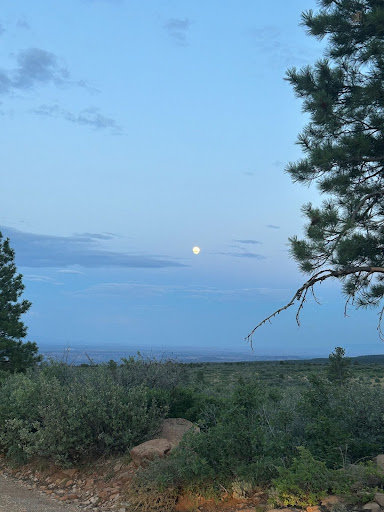The 2024 Public Lands Survey Team: Bears Ears
The Public Lands Survey team embarked on its third year of research in the summer of 2024, directed by Cyndy Hines.
It was the second year in which the team dug into the concept of Dark Skies in the Rocky Mountain West, a topic of great importance as it is one of the fastest growing regions in the country. The unimpeded night sky has been essential to many peoples throughout history, shown in rock art of complex celestial events and indigenous creation stories.
Full Moon in Bears Ears, UT

Photo by Alice O’Neal-Freeman
Dark Skies researchers Alison, Megan, Mustafa, and Natasha each conducted their own research projects over the course of summer 2024. They are all connected to the pervasiveness of light pollution, and delve into the complexity of Bears Ears. They prepared by completing a workshop on interviewing and doing research for multiple blocks before heading out into the field.
In 2009 the FBI and BLM conducted one of the US’s largest raids of stolen archaeological and cultural artifacts in Blanding, UT, a town near Bears Ears. Bears Ears was initially made a monument in order to prevent such looting, but a monument designation also prevents gas companies from taking advantage of the oil in the area. Obama designated the area a national monument of over a million acres in 2016. During his first term in 2017, president Trump reduced its size by 85%. In 2021, president Biden restored the monument to its original size. In 2022 the BLM, the Forest service, and the Inter-tribal coalition began co-management of Bears Ears National Monument. Natasha surveyed for awareness of the new co-management plan.
There is a growing threat of light pollution from towns surrounding the monument, such as Blanding. Many indigenous people who have historically inhabited this land have deep cultural connections to the stars– Mustafa conducted surveys to understand this better– and some want to protect the Milky Way view by obtaining the designation of Dark Sky Park for the monument. Megan took artificial light measurements at night and tracked development in order to predict the impact nearby towns could have on Bears Ears night sky visibility in the future. Alison focused on light pollution and development in the greater Rocky Mountain region.
But would a Dark Sky Park designation attract more tourism and development itself? Could this damage the land because there is not much infrastructure in place? There are only two rangers working in a protected area bigger than Grand Canyon National Park. Some say designating it a national monument in the first place attracted more tourists than they have the facilities to accommodate. Many living in Southeast Utah have conflicting views of where to go from here. Some wish it was not even made a monument in the first place. Some feel the region is now a bigger political stage, and the residents’ preferences for land use are not being prioritized.
Description by Alice O'Neal-Freeman


